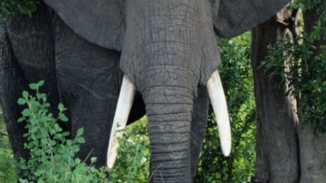
识牙寻踪
Elephant Ivory DNA Reveals Poaching Hotspots
识牙寻踪
Almost all the ivory in large stockpiles seized by law enforcement originates in just two locations in Africa, informing authorities about where to focus their resources.
近乎所有被强制查封的象牙库存仅来源于非洲大陆的两个地点。这个现象提醒了有关部门何处应被关注。
撰文/播音 史蒂夫·米尔斯基 (Steve Mirsky)
翻译 Meatle
审校 乔虹
“There are about 50,000 elephants a year being killed right now with only about 450,000 left in Africa.”
“现时,每年有将近5万头大象被杀死,而如今非洲仅存45万头大象
Samuel Wasser, director of the Center for Conservation Biology at the University of Washington.
华盛顿大学保护生物学中心的主管,塞缪尔·瓦瑟尔(Samuel Wasser)说。
“And one of the complexities of this problem is dealing with this transnational organized crime, where you have these sophisticated networks of criminal entities that are experts at moving contraband from one place to another without it being detected.”
“而问题复杂性的其中一个方面是,这是一种跨国犯罪,其中犯罪组织组成了复杂的网络,他们精于将走私货物转至买家手中,而不被发现。”
Wasser spoke February 14th at the annual meeting of the American Association for the Advancement of Science in Washington, D.C.
瓦瑟尔在2月14日华盛顿DC的美国科学技术促进会(The American Association for the Advancement of Science)的年度会议上说。
“What we have done is we’ve tried to focus our attention using genetics to determine the source of the actual poaching and to figure out how many major source populations are there. Because in doing that you can potentially focus law enforcement on those areas…
“我们所做的是,尝试集中我们的精力去考察基因信息,从而确定狩猎行为的发生地,并找出象牙产地的总数。经由这些研究,我们可以大概确定执法机关应该关注的地点…”
“Now the way that we focus on this work is we use DNA from large ivory seizures…worth a minimum of a million dollars…and that is the seizures that bear the signature of large organized crime syndicates…
“The work we published in Science last July showed that virtually 100 percent of all large ivory seizures that we analyzed in the last decade came from really just two locations. Twenty-two percent of the ivory was made up of forest elephant ivory, and that came from an area we call the Tridem, which is the northeast corner of Gabon and northwest corner of Congo. And 78 percent of the ivory was savannah ivory, and that all came from Tanzania and the areas just bordering Tanzania. So Tanzania clearly is the biggest hotspot that we have encountered in this trade…
“现时,我们在该工作上通过检测大量检获的象牙的DNA,以确定我们应关注的目标。这些被检获的象牙总价值至少在100万美元,并且具有大型犯罪组织管理的痕迹。”
“我们上年7月发表在《科学》( Science )杂志上的研究成果说明了,事实上,过去10年来我们所研究的大量检获的象牙仅仅来自两个地点。其中22%的象牙源于被称为Tridem的地方,并出自丛林象身上。Tridem位于加蓬东北部与刚果西北部的交界处。剩下的78%的象牙则是出自坦桑尼亚与周边地区的草原象。因此坦桑尼亚显然是我们所遇到的最大的热点。”
[S.K. Wasser et al, Genetic assignment of large seizures of elephant ivory reveals Africa’s major poaching hotspots]
“One of the things that this suggests is that the number of kingpins driving this trade are relatively few because so much of this big trade is focused in one area...
“这项研究所展示的其中一点是,驱动这项贸易的轴心数目相对较少,因为太多的贸易集中在一个地区。”
“Our work has already brought down one of the largest ivory dealers in West Africa. We are now hot on the trail of probably the largest ivory dealer in Africa.”
“我们的研究已经成功的捣毁西非的其中一个最大的象牙贸易团伙。现在,我们正密切追踪可能是非洲最大的象牙贸易商。”
未经书面许可任何人不得复制或镜像
京ICP备11000850号-1
 京公网安备11010502039775号
京公网安备11010502039775号 信息网络传播视听节目许可证0111611号
国家科技基础条件平台

















